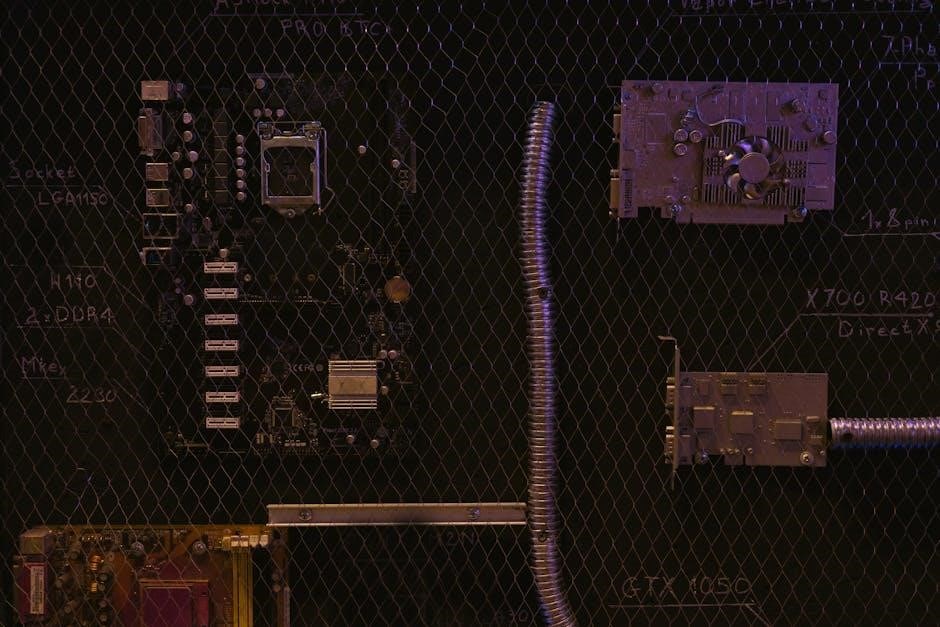The Hornet 563T Wiring Guide is an essential resource for installing, troubleshooting, and optimizing the system. It provides a detailed visual blueprint of the electrical setup, using color codes and standardized symbols to simplify component identification and connections. This guide is crucial for ensuring proper installation, diagnosing issues, and maintaining optimal performance, making it indispensable for technicians and installers.
1.1 Overview of the Hornet 563T System
The Hornet 563T is a sophisticated car security system designed to enhance vehicle protection and convenience. It integrates advanced features like remote start, alarm functions, and sensor inputs. The system is built to provide reliable performance, ensuring safety and ease of use. This guide focuses on its electrical setup, helping users understand the components, connections, and troubleshooting processes. Whether for installation or maintenance, the Hornet 563T system requires precise wiring to ensure all features operate seamlessly and efficiently.
1.2 Importance of Proper Wiring
Proper wiring is critical for the Hornet 563T system to function correctly. Incorrect connections can lead to electrical issues, system malfunctions, or even damage to components. Ensuring wires are connected accurately prevents short circuits, optimizes performance, and enhances reliability. This guide provides clear instructions to help users avoid common mistakes, ensuring a safe and efficient setup. Proper wiring also simplifies future troubleshooting and maintenance, making it essential for both installation and long-term functionality of the Hornet 563T system.

Understanding the Wiring Diagram
The wiring diagram serves as a visual blueprint of the Hornet 563T electrical system, detailing connections and components. It uses standardized symbols and color codes to simplify identification and tracing of circuits, ensuring clarity for installers and technicians.
2.1 Components of the Wiring Diagram
The wiring diagram for the Hornet 563T includes detailed representations of wires, connectors, and components. It features symbols for the main control module, sensors, and output devices, along with color-coded wires to indicate their functions. The diagram also outlines connections between components, such as fuses, relays, and switches, ensuring clarity for installers. Understanding these components is essential for accurately interpreting the diagram and ensuring proper system functionality. Each element is labeled to simplify identification and tracing during installation or troubleshooting.
2.2 Color Codes and Their Meanings
The Hornet 563T wiring guide uses standardized color codes to identify wire functions. Yellow wires typically represent alarm trigger inputs, while red wires indicate constant power sources. Black wires are usually ground connections, and orange wires often signify accessory outputs. These color codes simplify wire identification, ensuring accurate connections during installation. Understanding the color coding system is crucial for efficiently troubleshooting and maintaining the system. Each color corresponds to a specific function, making it easier to trace circuits and diagnose issues quickly and effectively.
2.3 How to Read the Wiring Diagram
Reading the wiring diagram for the Hornet 563T involves understanding its visual representation of the electrical system. Start by identifying the components, such as sensors, modules, and output devices, which are represented by standardized symbols. Trace the wires, noting their connections and color codes, to understand how the system operates. Use the diagram to locate circuit paths and verify connections. Refer to the legend for symbol meanings and color code functions. This process ensures accurate installation, efficient troubleshooting, and effective system maintenance, making the diagram an indispensable tool for technicians and installers.

Installation Steps
The Hornet 563T installation involves pre-installation checks, step-by-step wiring, and best practices for a clean setup. Follow the wiring diagram to connect components accurately and ensure system reliability.
3.1 Pre-Installation Checks
Before starting the installation, ensure all components and tools are ready. Verify the wiring diagram matches your system and check for any damaged or missing parts. Ensure the vehicle’s electrical system is compatible with the Hornet 563T. Disconnect the battery to prevent electrical shocks. Review the guide to understand color codes and connection points. Test all sensors and input devices for proper functionality. Organize wires and connectors to avoid tangling. Ensure the control module is properly seated and secured. Double-check all connections for tightness and accuracy before proceeding.

3.2 Step-by-Step Wiring Process
Start by connecting the battery to the system, ensuring polarity is correct. Use the wiring diagram to identify and match color-coded wires to their respective terminals. Connect the main control module to the vehicle’s electrical system, ensuring secure fastening. Attach sensors and input devices, verifying proper alignment and functionality. Test each connection to confirm signal flow and integrity. Proceed to connect output devices, such as alarms and accessories, following the diagram’s instructions. Finally, connect the siren and test the entire system to ensure all components operate seamlessly. Always refer to the diagram for specific connection points and follow safety guidelines to avoid electrical issues.
3.3 Best Practices for a Clean Setup
Begin by connecting the battery to the system, ensuring correct polarity. Use the wiring diagram to match color-coded wires to their respective terminals. Securely fasten the main control module to the vehicle’s electrical system. Attach sensors and input devices, verifying proper alignment and functionality. Test each connection to confirm signal flow and integrity. Proceed to connect output devices, such as alarms and accessories, following the diagram’s instructions. Finally, connect the siren and test the entire system to ensure all components operate seamlessly. Always refer to the diagram for specific connection points and follow safety guidelines to avoid electrical issues.

Troubleshooting Common Issues
This section covers troubleshooting common issues, such as identifying faulty connections and diagnosing electrical problems. It also provides guidance on resetting the system for optimal performance.
4.1 Identifying Faulty Connections
Identifying faulty connections in the Hornet 563T system involves checking for signs of damage, corrosion, or loose wires. Use the wiring diagram to trace circuits and locate potential issues. Test continuity with a multimeter to ensure proper connections. Look for blown fuses or tripped circuit breakers, which may indicate overloaded circuits. Inspect connectors for dirt or moisture, as these can disrupt signals. Addressing faulty connections early prevents system malfunctions and ensures reliable performance. Always follow safety guidelines when handling electrical components to avoid further damage or risk.
4.2 Diagnosing Electrical Problems
Diagnosing electrical issues in the Hornet 563T system begins with consulting the wiring diagram to trace circuits and identify potential fault points. Use a multimeter to test voltage levels and continuity, ensuring all connections are secure. Check for short circuits, open connections, or faulty components. Inspect fuses and circuit breakers for damage or tripping. If issues persist, refer to the troubleshooting section for specific error codes or symptoms. Regular diagnostic checks help maintain system reliability and prevent unexpected malfunctions, ensuring optimal performance and safety.
4.3 Resetting the System
Resetting the Hornet 563T system is essential after diagnosing electrical issues or performing repairs. Start by disconnecting the battery to ensure no power flows through the system. Wait for 30 seconds to allow capacitors to discharge. Reconnect the battery and check for proper functionality. If issues persist, consult the wiring diagram to trace circuits and verify connections. Use a multimeter to test voltage levels and ensure all components are functioning correctly. Resetting the system helps restore default settings and ensures reliable operation, preventing further malfunctions and maintaining system integrity.

Key Components and Their Functions
The Hornet 563T system comprises essential components like the main control module, sensors, and output devices, each serving specific roles to ensure optimal functionality, security, and seamless integration.
5.1 Main Control Module
The main control module is the central brain of the Hornet 563T system, responsible for processing signals from sensors and controlling output devices. It manages alarm triggers, remote start functionality, and system responses. Proper wiring ensures accurate signal transmission and optimal performance. The module integrates seamlessly with accessories, enhancing security and convenience. Understanding its functions is crucial for effective troubleshooting and maintenance, ensuring the system operates as intended. Always refer to the wiring guide for specific connection details to avoid malfunctions.
5.2 Sensors and Input Devices
Sensors and input devices are critical for detecting events and triggering system responses. They monitor inputs like door closures, hood, and trunk activity, sending signals to the main control module. Proper wiring ensures accurate signal transmission, preventing false alarms. The Hornet 563T supports various sensors, including optional dual-stage sensors for enhanced security. These components are vital for the system’s functionality, enabling features like Warn Away and zone-specific alerts. Correct installation and wiring are essential for reliable performance and optimal security. Always follow the guide for precise connections.
5.3 Output Devices and Accessories
Output devices and accessories play a key role in enhancing the functionality of the Hornet 563T system. These include sirens, LED indicators, and remote controls, which provide visual and audible alerts. Accessories like additional remotes or keypads can be integrated to improve user convenience. Proper wiring of these components ensures seamless communication with the main control module. Always refer to the wiring guide for specific connection instructions to maintain system performance and reliability. Correct installation is vital for optimal functionality and security.

Safety Precautions
Always follow safety guidelines when working with electrical systems to prevent accidents. Handle sensitive electronics with care, avoid high-voltage wiring near sensors, and ensure proper grounding for safe installation.
6.1 General Safety Guidelines
When working with the Hornet 563T wiring, always prioritize safety to avoid accidents. Ensure the system is powered off before starting any work. Use insulated tools to prevent electrical shocks and wear protective gear like gloves and safety glasses. Avoid touching live wires or components to prevent damage or injury. Keep the workspace clean and well-lit to minimize risks. Never bypass safety features or ignore warning signs. Follow proper grounding procedures to ensure system stability and user safety. Adhere to all manufacturer guidelines for a secure installation process.
6.2 Handling Sensitive Electronics
When handling the Hornet 563T system’s sensitive electronics, extreme care is essential to prevent damage. Always ground yourself by touching a metal object or wearing an anti-static strap to discharge static electricity. Avoid touching components like sensors or the control module directly, as oils from skin can cause corrosion. Use clean, dry tools to connect wires and components. Handle circuit boards by the edges to prevent damage. Never bend or flex wires excessively, as this can cause internal breaks. Proper handling ensures long-term reliability and optimal performance of the system.

Tools and Materials Needed
Essential tools include wire cutters, strippers, crimpers, and connectors. Materials needed are high-quality wires, heat shrink tubing, and electrical tape for secure, durable connections.
7.1 Essential Tools for Wiring
The wiring process requires specific tools to ensure accuracy and safety. Essential tools include wire cutters for trimming wires to the correct length, wire strippers to remove insulation without damaging the conductor, and crimpers for securing connectors. Additionally, pliers are useful for bending wires, while screwdrivers (both flathead and Phillips) are needed for connecting components. A multimeter is also recommended for testing voltage and continuity. Using high-quality tools ensures reliable connections and prevents damage to the system.
7.2 Recommended Materials
To ensure a reliable and safe wiring setup for the Hornet 563T, specific materials are necessary. High-quality wires with appropriate gauge ratings are essential for optimal performance. Heat shrink tubing and electrical tape are recommended for insulating connections and protecting against environmental factors. Fuses and circuit breakers should be included to prevent overcurrent situations. Additionally, adhesive-lined connectors and cable ties can help organize the wiring neatly. Using these materials ensures a clean, durable, and secure installation, minimizing the risk of electrical issues and enhancing system longevity.
Warranty and Support Information
The Hornet 563T is backed by a one-year warranty covering defects in workmanship and materials. For support, contact Directed Electronics, Inc., or refer to the guide for details.
8.1 Warranty Coverage Details
The Hornet 563T is covered by a one-year warranty from Directed Electronics, Inc., starting from the purchase date. This warranty promises to repair or replace any defective electronic control module due to workmanship or material issues under normal use. The warranty applies only to the original purchaser and does not cover damage caused by misuse or improper installation. For more details, refer to the official documentation or contact Directed Electronics, Inc., customer support.
8.2 Contacting Customer Support
For assistance with the Hornet 563T, contact Directed Electronics, Inc., customer support. Call toll-free at 1-800-543-7527 (US/Canada) or 1-480-968-2000 (International). Visit their official website at www.directed.com for online support resources, FAQs, and contact forms. Email inquiries can be sent to support@directed.com. Ensure to have your product serial number and purchase details ready for efficient assistance. Directed Electronics is committed to providing timely and effective support to resolve any issues with your Hornet 563T system.

Additional Resources
Visit www.directed.com for official guides, tutorials, and FAQs. Explore community forums like dontforgettobeawesome.com for user discussions and tips; Access wiring diagrams at homewiring.academia.edu.
9.1 Online Guides and Tutorials
Access comprehensive online guides and tutorials for the Hornet 563T on websites like www.directed.com and dontforgettobeawesome.com. These resources offer step-by-step instructions, video tutorials, and downloadable diagrams to assist with installation and troubleshooting. Additionally, forums and communities provide peer-to-peer support, sharing tips and solutions for common issues. Utilize these resources to ensure a smooth and efficient setup process, leveraging expert advice and real-world experiences to maximize system performance and reliability.

9.2 Community Forums and Discussions
Engage with online communities and forums dedicated to the Hornet 563T to connect with experts and enthusiasts. Platforms like forums.directed.com and carsecurityforum.com offer valuable insights, troubleshooting tips, and real-world experiences. Users can ask questions, share installation stories, and gain feedback from experienced technicians. These forums are a great resource for resolving unique issues and learning from others who have worked with the system. Active participation can enhance your understanding and improve your wiring skills for the Hornet 563T.
The Hornet 563T Wiring Guide provides a comprehensive roadmap for successful installation, troubleshooting, and maintenance. By following the detailed diagrams, color codes, and best practices outlined, users can ensure optimal performance and reliability. Proper wiring is crucial for avoiding common issues and maximizing system functionality. Whether you’re a professional technician or a DIY enthusiast, this guide equips you with the knowledge to handle the Hornet 563T with confidence. Refer to additional resources and support channels for further assistance, ensuring a safe and efficient setup.






